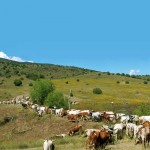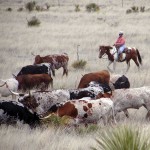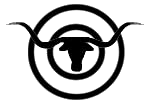Our herding is the same on Green River Farms– except on a much smaller scale. We use electric interior fences and barb wire exterior fences. Most cattle moves are simply done on foot, and when a family with six children run the farm there are plenty of feet to move our Devon/South Poll cattle. The same principles of low stress herding and handling apply on a 100 acres or a million acres. Rotation is still done almost daily on Green River Farm. The only difference is the size of pastures. In Tennessee we might move from five acres to five acres where on the Double Circle we might move miles between a 3,000 acre pasture to a 6,000 acre one. We still handle our cattle quietly and cull any cows who are not gentle and easy to work.
Because we follow intensive rotational grazing, we move our herd frequently. Almost daily, in fact!

Herding the steers to their next pasture.
Our cattle are all quite gentle and accustomed to our presence, as we work them just about every day. We use extremely low stress herding methods, and as our cowboys and cowgirls will attest, it is a slow process. Some ranches use trucks or ATVs for herding, and while that would work in some of the pastures at the Double Circle Ranch, we’ve found it is less stressful for the steers to be managed from horseback—or occasionally on foot—instead of from the inside of a diesel cab. Plus, there are many remote areas here that even an ATV can’t reliably access. Horses don’t use fuel or belch CO2 and they don’t tear up the ground the way motored vehicles do, and moreover, we rather like the idea that we’re managing our herd the same way it would have been done a few generations ago!
A day spent herding
Early in the morning, you take a truck or ATV out to the pasture where the horses are and saddle up right in the field. The horses change pastures regularly as well, but they’re not necessarily in the same pasture as the cattle. Once you are mounted, you’ll set off for the pasture where the steers are…it may be just around the corner, or you may be riding for a couple of hours before you get there! (Bring lunch. And sunscreen.) Most of us like to use cattle dogs to help out; if the dogs are along, they’ll be on foot from here on. By the way, if you’re a guest at the ranch, we’ll be alongside to provide pointers and help out. If you’re a Double Circle Cowboy (or Cowgirl – we have both!), you may have human companions or you may be doing this unassisted. It’s never the same experience twice.
Once you’ve got the cattle located, it’s time to drive them to their next pasture. This is a slow, calm, rather relaxing process. We’ll teach you a little about the Longhorn brain and herd mentality along the way, but in a nutshell, you want to keep the herd together and move it along at a nice ambling walk from a position at the back. You can’t pull a steer, but you can ‘push’ one! With a little experience you’ll learn to ‘read the cattle,’ identifying what various head positions and expressions mean and anticipating behaviors.
When the herd arrives at its new pasture, the gate is opened and we take a head count. If the count is good, the day is over….just as soon as we ride back to the horse pasture and reward our mounts for a job well done. If the count is low, we have to scour the original pasture for the missing cattle, also looking for places where they might have snuck through a downed section of fence or a gate left open.
Herding is an art, but it is also a science. Whole books have been written about stockmanship and herding, how to drive a large herd when you are alone, how to work most effectively in pairs or teams….it’s rather fascinating, considering the end result is simply taking a big group of cattle for a walk! It sounds simple enough, but when you are one person on horseback and they are 200 Longhorn steers, it’s not quite as easy as it sounds.
Training to herd

We stay near the back of the herd when we move them.
Longhorns as a breed don’t always stick together; small groups often break off from the main herd, and individuals will sometimes strike out alone. And like any cattle, they don’t intuitively know how to be herded. If you take a herd of Longhorns (or any breed!), leave them alone in the field all season and then suddenly try to herd them, you will need a whole mess of cowboys, a vat of patience and a lot of time. Days and days of it. We move our cattle constantly, partly because that is what we’ve found is best for the land, and partly because that conditions them to being herded. They know how it works, and for the most part, they are extremely cooperative. (Wouldn’t you cooperate too, if you were a vegetarian and knew there was fresh salad waiting for you at the end of a walk with your buddies?)
Training the horses and the dogs is fairly similar: they just do it a lot, day after day, and they figure it out eventually. Horses need to be extremely sure-footed, sensible and not spooky. Dogs need to be under excellent voice control with a basic set of commands. Genetics help too, as some dogs and some horses are predisposed to naturally do really well around cattle.
For the humans, we find the most important thing is to be a quiet, calm rider and very patient. Someone who gets worked up about a difficult ride or a missing steer is likely to throw their horse off, not to mention stressing out a few hundred steers. Herding is not an activity to do when you have an appointment in a few hours, but for someone who enjoys taking in remote scenery from the back of a good horse and appreciates the thrill of being an active player in a living history, it can be a most enjoyable experience!


